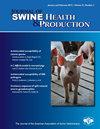商品化生产中育肥猪季节性生长规律的回顾性分析
IF 0.7
4区 农林科学
Q3 Agricultural and Biological Sciences
引用次数: 3
摘要
目的:确定位于中西部的3个美国商业生产系统中苗圃和修整器生长性能的季节模式。材料和方法:从3个生产系统收集5年的生产记录,包括5039个苗圃和5354个整理器生产批次。解释性变量包括系统、地点、猪流量类型、饲养器类型、批量、放置周、平均饲养天数、填充长度、母猪养殖场来源数量、膳食能量、死亡率和初始体重。安置周是季节性模式的单位。使用多级线性混合模型,在单独的数据集中分析了育婴室和育肥室的表现(平均日增重[ADG]、平均日采食量[ADF]和增重饲料比[G:F])。采用引导逐步选择方法来选择固定变量及其相互作用。季节性曲线是使用具有5周窗口和1周步长的最小二乘均值的滚动平均值生成的。结果:对于苗圃,ADG、ADFI的季节性效应显著(P<0.001),而G:F的季节性影响不显著。从一年中的第1周到第20周,幼儿园ADG和ADFI随着安置周的进展而下降,但此后有所增加。所有修整器的生长反应都受到放置周的影响(P<.001),但不同系统之间的季节变化模式和幅度不同(系统×周的相互作用,P<.02)。含义:苗圃和修整器性能的季节变化可以使用多级线性混合模型中的生产记录来量化。季节性对整理者表现的影响是系统依赖性的,而苗圃季节性在所调查的系统之间具有更大的相似性。本文章由计算机程序翻译,如有差异,请以英文原文为准。
A retrospective analysis of seasonal growth patterns of nursery and finishing pigs in commercial production
Objective: Determine seasonal patterns of nursery and finisher growth performance in 3 commercial US production systems located in the midwest. Materials and methods: Five years of production records, including 5039 nursery and 5354 finisher production batches, were collected from 3 production systems. Explanatory variables include system, site, pig-flow type, feeder type, batch size, week of placement, average days-on-feed, fill length, number of sow farm sources, dietary energy, mortality, and initial body weight. Week of placement served as the unit for seasonal patterns. Nursery and finisher performance (average daily gain [ADG], average daily feed intake [ADFI], and gain to feed ratio [G:F]) were analyzed in separate datasets using multi-level linear mixed models. A guided stepwise selection approach was used to select fixed variables and their interactions. Seasonality curves were generated using rolling averages of least squares means with a 5-week window and 1-week step-size. Results: For nursery, the seasonality effect was significant (P < .001) for ADG, ADFI, but not for G:F. Nursery ADG and ADFI decreased as week of placement progressed from the 1st to 20th week of a year but increased thereafter. All finisher growth responses were affected by week of placement (P < .001) but the pattern and magnitude of seasonal variability differed among systems (system × week interactions, P < .02). Implications: Seasonal variability of nursery and finisher performance can be quantified using production records in a multi-level linear mixed model. Seasonality effects on finisher performance were system dependent, while nursery seasonality shared more similarity among investigated systems.
求助全文
通过发布文献求助,成功后即可免费获取论文全文。
去求助
来源期刊
CiteScore
1.80
自引率
0.00%
发文量
29
审稿时长
>36 weeks
期刊介绍:
The Journal of Swine Health & Production (JSHAP) is an open-access and peer-reviewed journal published by the American Association of Swine Veterinarians (AASV) since 1993. The aim of the journal is the timely publication of peer-reviewed papers with a scope that encompasses the many domains of applied swine health and production, including the diagnosis, treatment, management, prevention and eradication of swine diseases, welfare & behavior, nutrition, public health, epidemiology, food safety, biosecurity, pharmaceuticals, antimicrobial use and resistance, reproduction, growth, systems flow, economics, and facility design. The journal provides a platform for researchers, veterinary practitioners, academics, and students to share their work with an international audience. The journal publishes information that contains an applied and practical focus and presents scientific information that is accessible to the busy veterinary practitioner as well as to the research and academic community. Hence, manuscripts with an applied focus are considered for publication, and the journal publishes original research, brief communications, case reports/series, literature reviews, commentaries, diagnostic notes, production tools, and practice tips. All manuscripts submitted to the Journal of Swine Health & Production are peer-reviewed.

 求助内容:
求助内容: 应助结果提醒方式:
应助结果提醒方式:


